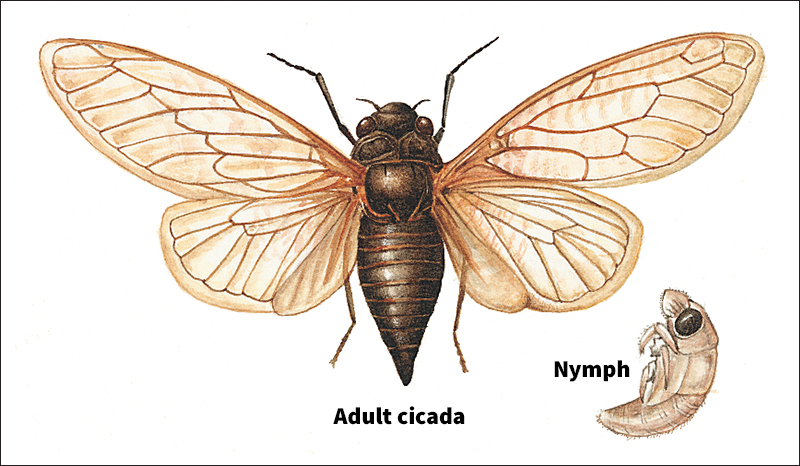Cicada << suh KAY duh or suh KAH duh >> is a heavy-bodied insect with four thin wings which it folds over its body like a triangular roof. It can measure 1 to 2 inches (2.5 to 5 centimeters) long. It has a wide head and short, bristlelike antennae (feelers). Most cicadas live in tropical and subtropical areas, but many types live in North America.
Cicadas are commonly known for the buzzing song the male makes. The male makes two drumlike membranes (thin sheaths of skin) on the abdomen vibrate rapidly to produce the sound. The sound attracts females or calls large numbers of males together. Each species (kind) of cicada has its own song. Many types of male cicadas often assemble in large groups and produce a loud chorus of sounds.
Loading the player...Cicada
Types of cicadas.
Cicadas can be either annual or periodic. An example of an annual cicada is the dog-day cicada. Dog-day cicadas are large, dark, and often have greenish markings. They appear each year in July and August. It takes from four to seven years for a dog-day cicada to develop from an egg into an adult. But some adults are seen each year, because different broods (groups of young) develop at different times.

Periodical cicadas are dark and have red eyes. They appear in late May and early June. Periodical cicadas take either 13 years or 17 years to develop, depending on where they live.
Cicadas that take 17 years to develop are sometimes called 17-year locusts. Adult periodical cicadas thus appear in a region only once every 13 or 17 years. But so many broods exist that they appear somewhere in the United States nearly every year. Since these cicadas appear in large numbers only once every 13 to 17 years, predators cannot rely on these insects as their primary source of food. However, when all the cicadas emerge at once, there are too many for the predators to eat, leaving the surviving cicada able to reproduce and continue the cycle.
Development.
A female cicada lays her eggs in the twigs of trees and shrubs. She places the eggs in small holes that she makes with a sawlike organ near the tip of her abdomen. The twigs usually are so badly injured by the process that the tips of the twigs die. In a few weeks, the eggs hatch and young cicadas called nymphs appear. They fall to the ground, enter the soil, and feed on roots. A nymph remains in the ground until it is full-grown. Then it comes out of the ground and climbs a tree or some other object. It sheds its skin, and emerges as an adult. It feeds on tree sap. The adult cicada has a life span of only a few weeks. 
